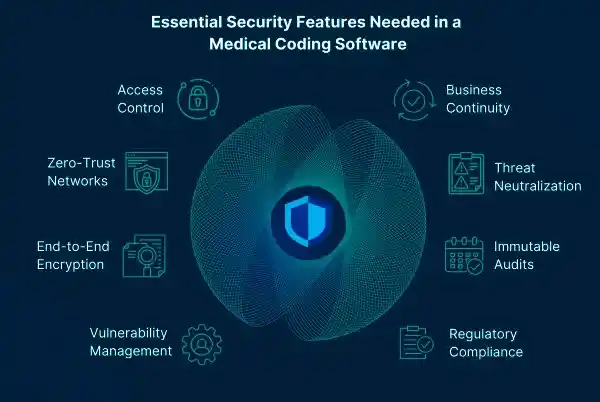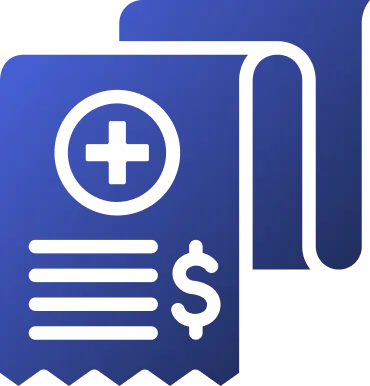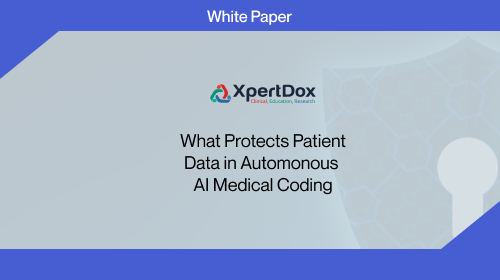Table of Contents
What Makes Autonomous Medical Coding the Future of Healthcare?
Essential Security Features Needed in an Automated Medical Coding Solution
How Compliant & Secure is Your Medical Coding Solution?
FAQs
Manual medical coding or human coding has been the norm for decades. However, it adds to the administrative costs, which already hover at the higher end of the spectrum at 34.2% of total health expenditures at $2497 per capita.
Apart from the financial drain, it also elongates insurance settlement cycles, hampers productivity, and is time and resource intensive. Not to mention that it requires comprehensive review and is still prone to mistakes and errors. Against this background, AI medical coding and billing solutions have been making waves by digitizing the entire process.
Here's a look at how autonomous medical coding can transform medical practices and patient care without compromising security and compliance.
What Makes Autonomous Medical Coding the Future of Healthcare?
Higher Efficiency & Accuracy:
AI medical coding solutions blend PPT - process, people, and technology - to generate codes quickly and as per industry standards. The high-fidelity model reduces workload, claims denial or rejections, and errors.Faster Claims Settlement:
Manual medical coding is time and resource-consuming. Errors and discrepancies can add to the backlog and delay. Medical coding software can automate the entire workflow, thereby saving time and resources.Accelerated Revenue Cycles:
Integrating autonomous medical coding and billing solutions makes Revenue Cycle Management or RCM easier. Such proactive RCM makes financial planning, revenue forecasting, resource allocation, and growth tracking easier.Patient-Centric Care:
With medical professionals no longer burdened with repetitive, manual, and unproductive tasks, they can focus more on providing better patient care. Further, the streamlining of processes and standardization of data improves services.Lower Cost:
Automated medical coding reduces administrative cost overheads and frees up resources for more productive tasks. Such benefits have a cumulative effect in lowering costs and improving the organization's bottom line.
Of course, healthcare organizations can enjoy such advantages of autonomous medical coding software only when it rests on the foundations of patient data security and confidentiality.
Fortunately, several legal and regulatory bodies have taken cognizance of these changing dynamics and implemented stricter data governance policies. As a result, most automated medical coding solutions are vying to comply and adhere to various guidelines, which should assuage most concerns.
Further, there is a growing consciousness of the ethical considerations that come to play while entering these territories. Most organizations embrace the principles of privacy, transparency, and consent to make the right choices.
In the next section, we look at some key security features of automated medical coding platforms that are markers of trust and security, holding the promise of the above benefits.
Essential Security Features Needed in an Automated Medical Coding Solution

Now that the value proposition of autonomous medical coding is clear, it's time to dive deeper into the salient security and compliance features. Here are a few must-haves:
1. End-to-End Encryption
Since data movement will be involved, whether from hospitals and healthcare centers to cloud storage or insurance providers, such transfers, storage, and access points must be end-to-end encrypted.
Encryption maintains patient confidentiality and privacy throughout the data lifecycle, even if there are attempts by malicious entities to intercept data.
2. Access Control
Features like role-based access and multifactor authentication, commonly found in AI-powered autonomous medical coding solutions like XpertCoding, can ensure that only authorized personnel can access or modify patient data. Besides preventing patient data tampering, access controls safeguard the AI coding system.
Additional features like version control can grant visibility into who has made changes to the data and processes to identify actors.
3. Zero Trust Networks
As the name suggests, zero-trust networks treat every activity, user, session, or device as suspicious until proven otherwise.
Resultantly, even those accounts accessing information from within the organization must undergo the requisite authentication process before gaining access and interacting with the medical coding platform. Such a framework prevents data breaches and unauthorized access.
4. Regulatory Compliance
AI medical coding solutions must comply with HIPAA , GDPR, and ISO/IEC 27001 regulations. Compliance indicates that necessary measures have been taken to implement robust security measures and protocols such as data anonymization, proper data handling, consent management, etc.
Solutions that comply with these regulatory frameworks minimize liability and act as a badge of trust. Patients and insurers are more likely to trust and share data with organizations that conform to such policies.
5. Threat Neutralization
Autonomous medical coding software should come with reliable threat detection and mitigation capabilities. More importantly, these frameworks should be highly responsive and deploy in real time when an incident is registered.
AI medical coding platforms can also turn to ML-powered algorithms to make security more predictive than reactive. Such a combination strategy will prevent and contain threats.
6. Vulnerability Management
Vulnerability management is yet another component of proactive security. It entails regular code testing, security updates, patch management, and penetration testing.
Such a comprehensive strategy frequently evaluates the autonomous medical coding solution and identifies and remediates any vulnerabilities malicious actors can exploit. This process must be continuous and repetitive to keep up with emerging threats.
7. Business Continuity
Whether it is data breaches or unprecedented technical issues, automated medical coding solutions must come with business continuity management systems to minimize disruptions. Compliance with ISO 22301:2019 marks that the solution can conduct cross-functional risk assessments and impact analyses to ensure the continuity of critical business functions.
8. Immutable Audits
The automated medical coding and billing software solution must document a tamper-proof record of system activities. Such audit trails, especially those in accordance with the SOC/SOC-2 reports , allow for greater accountability and thorough investigations. It creates an environment of transparency and compliance, which enhances overall security.
How Compliant & Secure is Your Medical Coding Solution?
Medical coding solutions offer a range of benefits, including improved compliance, fewer errors, higher revenue, and expedited claims settlement. However, since these systems contain a trove of sensitive patient information, they must be equipped with robust security measures.Privacy and security features like end-to-end encryption, access control, threat neutralization, etc., also help the system be compliant.
While the concerns surrounding patient data privacy and security are valid, much of it can be countered with selecting the right autonomous medical coding platform. We’ve covered some key security and compliance features that are a must-have for organizations looking to capitalize on the benefits of automated medical coding.
Autonomous medical coding incorporates advanced features like end-to-end encryption, access management, zero trust networks, regulatory compliance, etc., can help healthcare establishments transform their security and compliance functions while using automation to optimize the coding process.
Solutions like XpertCoding AI medical coding software aid in developing a more robust ecosystem for handling patient data safely and securely.
Streamline workflows with Autonomous Medical Coding. Use AI medical coding for accurate and efficient coding. Harness the power of AI and automation to optimize your medical coding process with ease. Improve accuracy, efficiency, and reduce costs with automated medical coding.
Want to learn more about XpertDox? Please reach out to us
Frequently Asked Questions
-What key security features should a reliable autonomous medical coding solution have?
A comprehensive autonomous medical coding solution should include essential security features such as end-to-end encryption, access control, zero-trust networks, regular vulnerability assessments, and detailed audit trails. These features collectively ensure the integrity and confidentiality of patient data and compliance with relevant regulations.
-Why is business continuity important for autonomous medical coding solutions?
Ensuring business continuity is crucial for maintaining uninterrupted medical coding and billing processes, especially in the face of data breaches or technical issues. Autonomous medical coding solutions with business continuity plans, compliant with standards like ISO 22301:2019, can quickly recover from disruptions, minimizing impact on healthcare operations and financial performance.
-How do autonomous AI medical coding solutions maintain transparency and accountability?
By documenting all system activities in immutable audit trails and adhering to standards like SOC/SOC-2 reports, AI autonomous medical coding solutions provide a transparent record of operations, facilitating thorough investigations and compliance checks whenever needed. This level of accountability is essential for maintaining trust and demonstrating adherence to security and compliance standards.
-How can autonomous medical coding solutions mitigate threats and manage vulnerabilities?
Autonomous medical coding systems employ threat detection and mitigation strategies, leveraging machine learning algorithms to anticipate and neutralize potential security threats proactively. Regular security assessments, including penetration testing and patch management, help identify and address vulnerabilities, ensuring the system's resilience against evolving cyber threats.

